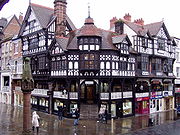
Black-and-white Revival architecture
Encyclopedia

Vernacular architecture
Vernacular architecture is a term used to categorize methods of construction which use locally available resources and traditions to address local needs and circumstances. Vernacular architecture tends to evolve over time to reflect the environmental, cultural and historical context in which it...
elements of the past, using timber framing
Timber framing
Timber framing , or half-timbering, also called in North America "post-and-beam" construction, is the method of creating structures using heavy squared off and carefully fitted and joined timbers with joints secured by large wooden pegs . It is commonplace in large barns...
. The wooden framing is painted black and the panels between the frames are painted white. The style was part of a wider Tudor Revival in 19th-century architecture.
Nikolaus Pevsner
Nikolaus Pevsner
Sir Nikolaus Bernhard Leon Pevsner, CBE, FBA was a German-born British scholar of history of art and, especially, of history of architecture...
describes the movement as a "Cheshire
Cheshire
Cheshire is a ceremonial county in North West England. Cheshire's county town is the city of Chester, although its largest town is Warrington. Other major towns include Widnes, Congleton, Crewe, Ellesmere Port, Runcorn, Macclesfield, Winsford, Northwich, and Wilmslow...
speciality", but states that it was not created in Cheshire and is not confined to the county. The earliest example noted by Pevsner is the Henry VII Lodge in Woburn Sands
Woburn Sands
Woburn Sands is a small town and civil parish that is mainly located in the Borough of Milton Keynes, England, and to the south-east of Milton Keynes itself, near Wavendon...
, Bedfordshire
Bedfordshire
Bedfordshire is a ceremonial county of historic origin in England that forms part of the East of England region.It borders Cambridgeshire to the north-east, Northamptonshire to the north, Buckinghamshire to the west and Hertfordshire to the south-east....
, built in 1811. The other example he gives is the Court House in Worsley
Worsley
Worsley is a town in the metropolitan borough of the City of Salford, in Greater Manchester, England. It lies along the course of Worsley Brook, west of Manchester. The M60 motorway bisects the area....
, which was built in 1849. The first Cheshire architect to be involved in the movement was T. M. Penson
Thomas Mainwaring Penson
Thomas Mainwaring Penson was an English surveyor and architect who is credited with pioneering the revival of half-timbered architecture in Chester in the 1850s....
who restored the house at No. 22 Eastgate Street, Chester in 1852 in the black-and-white style. This was followed by his further restorations in Eastgate Street, at Nos. 34–36 in 1856 and No. 26 in 1858. However Pevsner considers that Penson's works were "moderate in size and not very knowledgeable in detail".
The movement was improved when John Douglas
John Douglas (architect)
John Douglas was an English architect who designed about 500 buildings in Cheshire, North Wales, and northwest England, in particular in the estate of Eaton Hall. He was trained in Lancaster and practised throughout his career from an office in Chester, Cheshire...
and T. M. Lockwood
Thomas Lockwood
Thomas Meakin Lockwood was an English architect whose main works are in Chester, Cheshire, England. Lockwood, together with Thomas Penson and John Douglas, were the architects mainly responsible for the black-and-white revival buildings in the city centre. Lockwood designed a number of buildings...
"discovered the medium". They were the principal architects of the movement and they "transformed the street frontages of the city with their black and white buildings". Major examples of their work are Lockwood's building opposite Chester Cross at No. 1 Bridge Street
1 Bridge Street, Chester
1 Bridge Street, Chester, is at the junction of Bridge Street and Eastgate Street at Chester Cross in the centre of the city of Chester, Cheshire, England. Its architecture is that of the black-and-white revival, it incorporates part of the Chester Rows, and has been designated by English Heritage...
of 1888 and the terrace
Terraced house
In architecture and city planning, a terrace house, terrace, row house, linked house or townhouse is a style of medium-density housing that originated in Great Britain in the late 17th century, where a row of identical or mirror-image houses share side walls...
of buildings on the east side of St Werburgh Street
2–18 St Werburgh Street, Chester
2–18 St Werburgh Street is a terrace consisting of a bank, shops and offices on the east side of St Werburgh Street and the north side of Eastgate Street, Chester, Cheshire, England...
of 1895–99 by Douglas. The black-and-white tradition in Chester continued into the 20th century.

